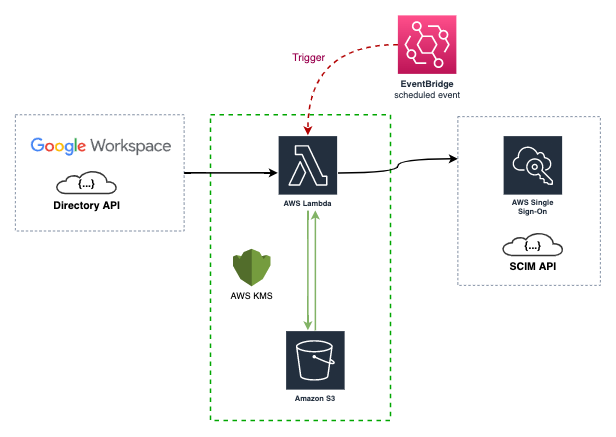idp-scim-sync










Keep your AWS IAM Identity Center (Successor to AWS Single Sign-On) in sync with your Google Workspace directory using and AWS Lambda function.

As the image above shows, the AWS Lambda function is triggered by a CloudWatch event rule, the event rule is configured to run every 15 minutes (default in the cfn template), and sync the AWS IAM Identity Center (Successor to AWS Single Sign-On) with Google Workspace directory using their respective APIs. During the first sync, the data of the Groups and Users are stored in the AWS S3 bucket as the State file
The State file is a custom implementation to save time and requests to the AWS SSO SCIM API, also mitigate some limitations of this.
This project is developed using the Go language and AWS SAM, a tool for creating, publishing and deploying AWS Serverless Applications in an easy way.
If you want to know what creates the CloudFormation Template, please check the AWS SAM Template
First time implementing AWS IAM Identity Center (Successor to AWS Single Sign-On)? please read Using SSO
The best way to to deploy and use this is through the AWS Serverless public repository - slashdevops/idp-scim-sync
Compatibility
AWS recently announced AWS Lambda Deprecates Go Runtime 1.x and posted this article Migrating AWS Lambda functions from the Go1.x runtime to the custom runtime on Amazon Linux 2 to help customers with the migration.
This project is already migrated since version v0.0.19 to the provided.al2 runtime and arm64 architecture, so you can use it without any problem.
| version |
AWS Lambda Runtime |
Architecture |
Deprecation Date |
| <= v0.0.18 |
Go 1.x |
amd64 (Intel) |
2023-12-31 |
| >= v0.0.19 |
provided.al2 |
arm64 (Graviton 2) |
---------- |
Features
Important
The documentation is a WIP and you can contribute!
Credentials
Repositories
Limitations
Most of the limitations of this project are due to AWS SSO SCIM API Limitations.
NOTES:
- The use of the The State file could mitigate the number
1, but I recommend you be cautious of these limitations as well.
- The project implements a well-known HTTP Retryable client (/go-retryablehttp) to mitigate the number
2, but I recommend you be cautious of these limitations as well.
Users that come from the project SSO Sync
- This project only implements the
--sync-method groups, so if you are using the --sync-method users_groups you can't use it, because this is going to delete and recreate your data in the AWS SSO side.
- This project only implements the
filter for the Google Workspace Groups, so if you are using the filter for the Google Workspace Users, you can't use it. Please see Using SSO for more information.
- The flags names of this project are different from the ones of the SSO Sync
- Not "all the features" of the SSO Sync are implemented here, and maybe will not be.
Components
- idpscim is a program for keeping AWS Single Sign-On (SSO) groups and users synced with Google Workspace directory service using the AWS SSO SCIM API. Details here.
- idpscimcli is a command-line tool to check and validate some functionalities implemented in
idpscim. Details here.
Requirements
How to use
To use this project you have different options, and depending on your needs you can use the following
In AWS
There are two ways to use this project in AWS and described below.
Using AWS Serverless Repository
This is the easy way, this project is deployed as an AWS Serverless Application in AWS Serverless Application Repository.
The public repository of the project is slashdevops/idp-scim-sync
NOTE: The repository depends on your AWS Region.
Using AWS SAM
This is the way if you want to build and deploy the lambda function from your local machine.
Requirements:
- git
- Go
- AWS SAM Cli
Validate, Build and Deploy:
# your AWS Cli Profile and Region
export AWS_PROFILE=<profile name here>
export AWS_REGION=<region here>
# validate
aws cloudformation validate-template --template-body file://template.yaml 1>/dev/null --profile $AWS_PROFILE
sam validate --profile $AWS_PROFILE
# build
sam build --profile $AWS_PROFILE
# deploy guided
sam deploy --guided --capabilities CAPABILITY_IAM --capabilities CAPABILITY_NAMED_IAM --profile $AWS_PROFILE
Are you using AWS Cli Profiles?, read AWS-SAM
In Local
You will have two ways to execute the binaries of this project in local, building these or using the pre-built stored in the github repository project.
Building the project
To build the project in local, you will need to have installed and configured at least the following:
- git
- Go
- make
Then you will need to clone the repository in your local machine, and execute the following commands:
- Compile for your Operating System:
make
then the binaries are in build/ folder.
Cross-compiling the project for Windows, MacOS and Linux (default)
make clean
make test # optional
make build-dist
then the binaries are in dist/ folder.
- Others Operating Systems, see the list of supported platforms in the syslist.go
make clean
GO_OS=<something from goosList in syslist.go> GO_ARCH=<something from goarchList in syslist.go> make test # optional
GO_OS=<something from goosList in syslist.go> GO_ARCH=<something from goarchList in syslist.go> make build-dist
then the binaries are in dist/ folder.
./idpscim --help
#or
./idpscimcli --help
Using the pre-built binaries
This is the easy way, just download the binaries you need from the github repository releases
Using the pre-built binaries in local
Example docs/Demo.md
License
This module is released under the Apache License Version 2.0:
 Directories
¶
Directories
¶



